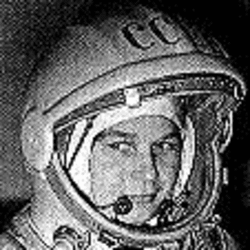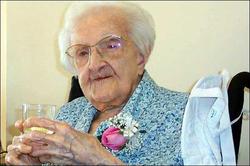LUCKY LADIES TRIVIA ANSWERS
Hope you did well and let me know in the Guestbook area how you did!
1) Valentina Vladimirovna Tereshkova:
The First Woman in Space
Colonel-Engineer Valentina Vladimirovna Tereshkova (March 6, 1937- ) was a Soviet cosmonaut and the first woman in space. She was on the Vostok 5 mission which launched on June 16, 1963, and orbited the Earth 48 times. The flight lasted 2.95 days (=70.8 hours). During her space mission, Tereshkova's radio call name was "Chaika," which means "seagull" in Russian.
The Vostok 5 spacecraft was recovered on June 19, 1963, in the Soviet Union. Tereshkova had parachuted from the spacecraft after earth's atmospheric re-entry; she landed about 380 miles northeast of Karaganda, Kazakhstan. Valentina Tereshkova was given the title "Hero of the Soviet Union," received the Order of Lenin, and was honored with the United Nations Gold Medal of Peace. She never flew in space again.
Tereshkova had been an expert in parachuting and a factory worker before she wrote to the Soviet space program, volunteering her service. She and the other candidates to be in the first woman in space were given extensive testing and interviews (beginning in December 1961). Tereshkova and Tatyana Torchillova were chosen in May 1963, to train for the Vostok 6 flight. Tereshkova was the final choice.
On November 3, 1963, Tereshkova married another cosmonaut (Andrian Nikolayev, who also went into space). They had a daughter, Elena Andrionovna, who was born in 1964; Elena (now a doctor in Russia) was the first child born to parents who both went into space. Tereshkova went on to graduate from the Zhuykosky Air Force Engineering Academy in 1969, and in 1976, earned a degree in Technical Science. 
3) First women elected to Congress?
Jeannette Rankin
Jeannette Pickering Rankin was born on June 11, 1880. Her father, John Rankin, was a rancher and lumber merchant and her mother, Olive Pickering, a former schoolteacher. She spent her first years on the ranch, then moved with the family to Missoula where she attended public school. She was the oldest of eleven children.
Rankin attended Montana State University at Missoula and graduated in 1902 with a bachelor of science degree in biology. She was a schoolteacher, seamstress and studied furniture design -- looking for some work to which she could commit herself. When her father died in 1902, he left money to Rankin, paid out over her lifetime.
On a long trip to Boston in 1904 to visit with her brother at Harvard and with other relatives, she was inspired by slum conditions to take up the new field of social work. She became a resident in a San Francisco Settlement House for four months, then entered the New York School of Philanthropy (later, to become the Columbia School of Social Work). She returned to the west to become a social worker in Spokane, Washington, in a children's home. Social work did not, however, hold her interest long - she only lasted a few weeks at the children's home.
Next, Rankin studied at the University of Washington in Seattle and became involved in the woman suffrage movement in 1910. Visiting Montana, Rankin became the first woman to speak before the Montana legislature, where she surprised the spectators and legislators alike with her speaking ability. She organized and spoke for the Equal Franchise Society.
Rankin then moved to New York, and continued her work on behalf of women's rights. During these years, she began her lifelong relationship with Katherine Anthony. She went to work for the New York Woman Suffrage Party and in 1912 she became the field secretary of the National American Woman Suffrage Association. Rankin and Anthony were among the thousands of suffragists at the 1913 suffrage march in Washington, D.C., before the inauguration of Woodrow Wilson.
Rankin returned to Montana to help organize the successful Montana suffrage campaign in 1914. To do so, she gave up her position with the NAWSA.
As war in Europe loomed, Rankin turned her attention to work for peace, and in 1916, ran for one of the two seats in Congress from Montana as a Republican. Her brother served as campaign manager and helped finance the campaign. Jeannette Rankin won, though the papers first reported that she lost the election -- and Jeannette Rankin thus became the first woman elected to the U.S. Congress, and the first woman elected to a national legislature in any western democracy.
Rankin used her fame and notoriety in this "famous first" position to work for peace and women's rights and against child labor, and to write a weekly newspaper column.
Only four days after taking office, Jeannette Rankin made history in yet another way: she voted against U.S. entry into World War I. She violated protocol by speaking during the roll call before casting her vote, announcing "I want to stand by my country, but I cannot vote for war." Some of her colleagues in NAWSA -- notably Carrie Chapman Catt -- criticized her vote as opening the suffrage cause to criticism as impractical and sentimental.
Rankin did vote, later in her term, for several pro-war measures, as well as working for the political reforms including civil liberties, suffrage, birth control, equal pay and child welfare. In 1917, she opened the congressional debate on the Susan B. Anthony Amendment, which passed the House in 1917 and the Senate in 1918, to become the 19th Amendment after it was ratified by the states.
But Rankin's first anti-war vote sealed her political fate. When she was gerrymandered out of her district, she ran for the Senate, lost the primary, launched a third party race, and lost overwhelmingly.
After the war ended, Rankin continued to work for peace through the Women's International League for Peace and Freedom, and also began work for the National Consumers' League. She worked, at the same time, on the staff of the American Civil Liberties Union.
After a brief return to Montana to help her brother run -- unsuccessfully -- for the Senate, she moved to a farm in Georgia. She returned to Montana every summer, her legal residence.
From her base in Georgia, Jeannette Rankin became Field Secretary of the WILPF and lobbied for peace. When she left the WILPF she formed the Georgia Peace Society. She lobbied for the Women's Peace Union, working for an antiwar constitutional amendment. She left the Peace Union, and began working with the National Council for the Prevention of War. She also lobbied for American cooperation with the World Court and for labor reforms and an end to child labor.
In 1935, when a college in Georgia offered her the position of Peace Chair, she was accused of being a Communist, and ended up filing a libel suit against the Macon newspaper. The court eventually declared her, as she said, "a nice lady."
In the first half of 1937, she spoke in 10 states, giving 93 speeches for peace. She supported the America First Committee, but decided that lobbying was not the most effective way to work for peace. By 1939, she had returned to Montana and was running for Congress again, supporting a strong but neutral America in yet another time of impending war.
Picture Above - Valentina Vladimirovna Tereshkova - Picture Below - Oldest Women To Ever Live
2) Julie Winnefred Bertrand 115 Years Old
The world's oldest known woman, Montrealer Julie Winnefred Bertrand, died on Thursday, passing away peacefully in her sleep.
She earned the distinction as the oldest living woman when 116-year-old Elizabeth Bolden of Tennessee U.S.A. died on Dec. 11, 2006.
Bertrand was born on Sept. 16, 1891 in Coaticook, a town in Quebec's Eastern Townships, and lived there for the majority of her life. She was the oldest of six children, and never married. She moved to Montreal after the death of her parents, and later moved into a nursing home.
She had never left her sixth-floor room in the nursing home for two years, but unexpectedly, she asked to tour the building the day before she died.
(Picture to your right - "Julie Winnifred Bertrand")
4) Who was Mary Kies?
Mary Kies was the first woman to receive a patent, for a method of weaving straw with silk.
5) Who was the first black women to receive an M.D degree?
Rebecca Lee Crumpler
6) Who is Anne Parrish?
Anne Parrish established, in Philadelphia, the House of Industry, the first charitable organization for women in America.
7) Félicité Angers?
Félicité Angers. Born January 9, 1845. Died June 6, 1924. This was the pen name of Laure Conan, author of nine novels of French Canadian Life. She was a witness to her time. She was the first French Canadian female novelist. All her novels centered on the 3 driving forces of French Canadian life, family, nation, and religion.

